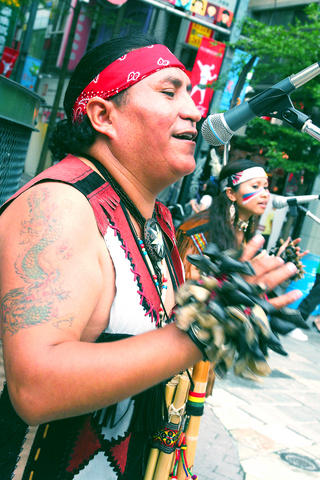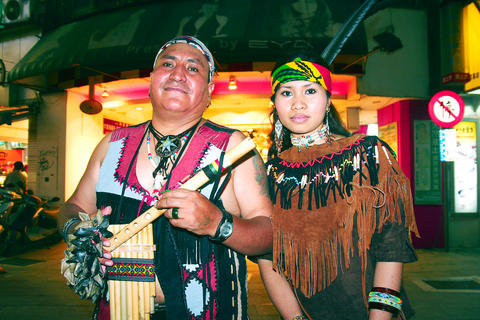She applies paint to her face and sticks two feathers in her hair. He winds a red bandana around his head. They both wear stylized American Indian tunics that he has painstakingly made by hand. There are two microphones on stands, a small mixer, two speakers and a mini disc player churns out Andean background music. An oil generator hums, generating electricity for the performance to come.
It's midweek in Ximending, Taipei, and the crowds are thinner than usual because a gray sky is promising more rain. Nevertheless, Karito and his girlfriend carry on with their preparations. He sticks two sheets of yellow paper on the monitor, one with a list of about 30 songs, the other with lyrics to a tune that Shalina is having trouble remembering.
Brave Hearts by Paul la Roche sets the tone. It's a new-age Native American standard that has a familiar melody and is intended to get the crowd going. If there was a crowd, that is. Though it's a pedestrian area, taxis and pickup trucks are driving by. A two-man police patrol swoops past. People are busy shopping and it will be a while before they gather to listen and watch the couple.

The 44-year-old Karito has a phoenix tattoo on one arm and a dragon on the other. He has beads around his neck and with his red-tinged skin and sharp features looks the part of an Andean folk musician, which is what he is. Flutes, pipes and percussion instruments dangle from his microphone stand and he takes turns to play them all.
Karito, real name Eduardo Uyuli Ramos, started playing the small guitar and flute in his native Bolivia when he was 7. He was brought up with his five brothers in Uyuni, a salt-mining city. His father worked at the hospital and his mother banned him from playing music when he was 12.
"She thought there was no future in it. She wanted me to go to college. At that time music was mainly played in bars by poor people who could do nothing else and it was associated with drinking and bad things," Karito says.

PHOTO: JULES QUARTLY, TAIPEI TIMES
After compulsory military service, Karito made it to university and studied economics for a year, before finding the courage to tell his mother he wanted to be an artist instead. Fortunately for Karito, the Bolivian government was promoting local folklore and offered full scholarships to musical students. His mother said he was old enough to follow his heart, so Karito did.
He studied music for three years when he was chosen to go to Austria and play at a festival. Then, the group went on tour in Europe for six months and the travel bug bit Karito. It was 1989 and since this time he has been a wandering minstrel, playing in bands, at concert halls, festivals and on the streets.
"I didn't want to go home. I wanted to travel more and show off my country's music and its culture. Inca music is about the Andes (South America's longest mountain range), the wind and the rain. You know, the wind makes melodies as it whistles through the rocks. I sing about how the flowers open after rain and the condor, how it soars and is free. This is our folklore. Some of our songs talk about our sadness, but most are about love and women."
In the past 18 years Karito has seen the world, been a member of five bands and produced around 15 albums. He first came to Taiwan in 1997 and has visited many times since. He met Shalina, whose real name is Sulistyowati, four years ago in Indonesia. She says of their first meeting at a Surabaya train station, "I saw a guy with a guitar who couldn't speak the language, so I helped him out."
Karito courted the 28-year-old and eventually met her parents, who agreed that she could join him on his musical journey. Then she went to Bolivia and learned about its culture. After overcoming her initial shyness she learned to play some instruments, dance and sing in Quechua (the original language of the Incas), hence her difficulty remembering the lyrics sometimes. They communicate in a mix of Spanish, Chinese and English.
Back in Ximending, Karito and Shalina are into their fourth or fifth song and a crowd of about 50 people has gathered. Kids, in particular, are spellbound by the performance. When they sing Ananau together, with its powerful chorus line, a tourist from China confides, "You know they're Aboriginals, don't you?"
"This happens quite often," Karito says, laughing. "Our music is similar because it comes from the mountains and from the heart. But in Bolivia we have many different kinds of rhythms, like the potosi, lambada and thinku. Thinku is a fight dance. People used to fight until someone died and then the farmers spread the blood on the ground, a sacrifice to the gods for good harvests. This was before the Spanish came (in the 16th century), when our gods were in nature."
"We also have sad songs because life can be tough in Bolivia. I worked in the salt mines for two years to pay tuition at university. We used coca leaves and cigarettes to keep us going. Many people died of tuberculosis in their 40s. But I don't sing so many of these songs when I perform, because I prefer to sing happy songs for the people."
"I don't want to return to Bolivia right now because I haven't lived there for so long. It has changed and I have changed. I've got used to traveling. When I was young, about 15, I worked with my father in the dispensary. My mother wanted me to be an office worker, but I would rather be an artist. For me it's not hard work when I sing and play, it makes me happy. If I could not do this I would be empty."
Karito is currently working on an album of his own songs and can be contacted at caritoed
@hotmail.com

One of the biggest sore spots in Taiwan’s historical friendship with the US came in 1979 when US president Jimmy Carter broke off formal diplomatic relations with Taiwan’s Republic of China (ROC) government so that the US could establish relations with the People’s Republic of China (PRC). Taiwan’s derecognition came purely at China’s insistence, and the US took the deal. Retired American diplomat John Tkacik, who for almost decade surrounding that schism, from 1974 to 1982, worked in embassies in Taipei and Beijing and at the Taiwan Desk in Washington DC, recently argued in the Taipei Times that “President Carter’s derecognition

This year will go down in the history books. Taiwan faces enormous turmoil and uncertainty in the coming months. Which political parties are in a good position to handle big changes? All of the main parties are beset with challenges. Taking stock, this column examined the Taiwan People’s Party (TPP) (“Huang Kuo-chang’s choking the life out of the TPP,” May 28, page 12), the Democratic Progressive Party (DPP) (“Challenges amid choppy waters for the DPP,” June 14, page 12) and the Chinese Nationalist Party (KMT) (“KMT struggles to seize opportunities as ‘interesting times’ loom,” June 20, page 11). Times like these can

June 23 to June 29 After capturing the walled city of Hsinchu on June 22, 1895, the Japanese hoped to quickly push south and seize control of Taiwan’s entire west coast — but their advance was stalled for more than a month. Not only did local Hakka fighters continue to cause them headaches, resistance forces even attempted to retake the city three times. “We had planned to occupy Anping (Tainan) and Takao (Kaohsiung) as soon as possible, but ever since we took Hsinchu, nearby bandits proclaiming to be ‘righteous people’ (義民) have been destroying train tracks and electrical cables, and gathering in villages

Dr. Y. Tony Yang, Associate Dean of Health Policy and Population Science at George Washington University, argued last week in a piece for the Taipei Times about former president Ma Ying-jeou (馬英九) leading a student delegation to the People’s Republic of China (PRC) that, “The real question is not whether Ma’s visit helps or hurts Taiwan — it is why Taiwan lacks a sophisticated, multi-track approach to one of the most complex geopolitical relationships in the world” (“Ma’s Visit, DPP’s Blind Spot,” June 18, page 8). Yang contends that the Democratic Progressive Party (DPP) has a blind spot: “By treating any